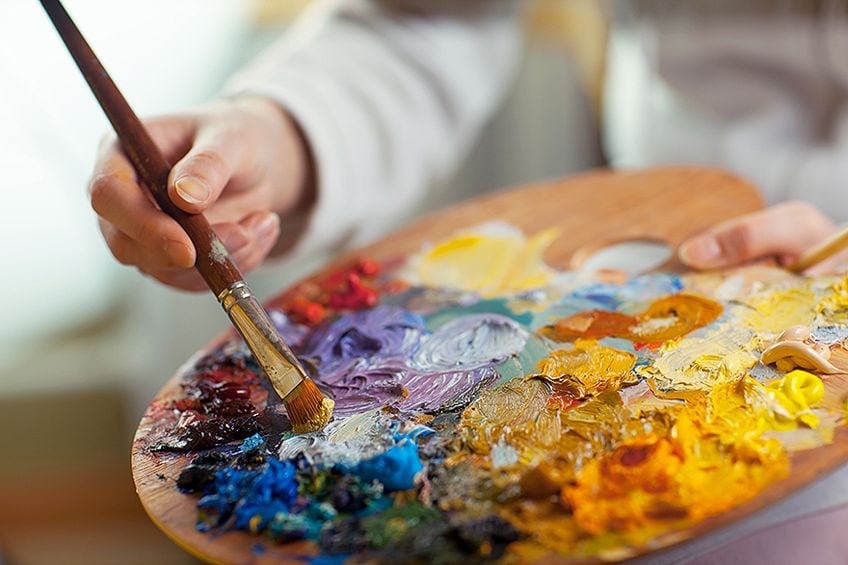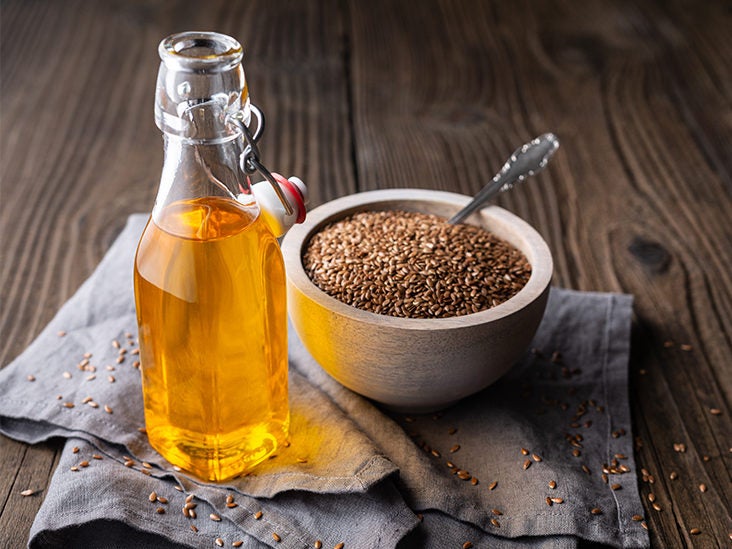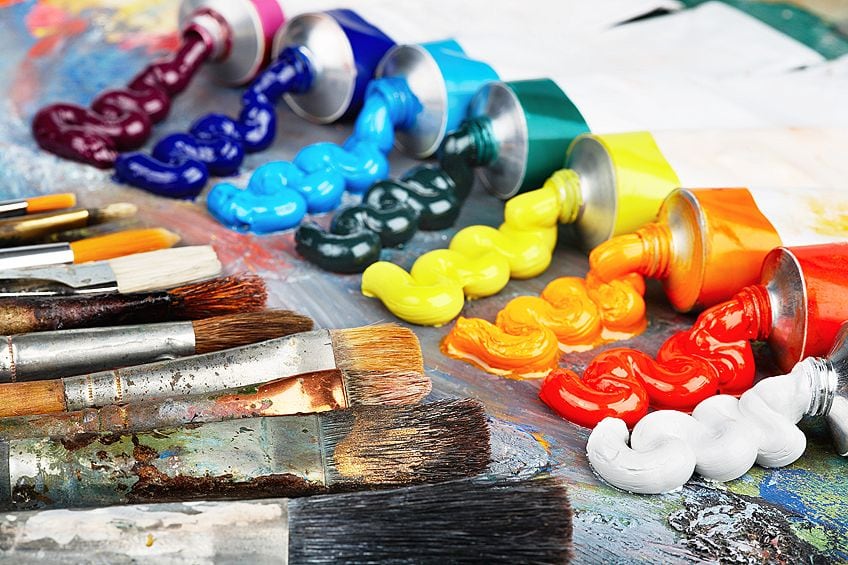
Oil paint is a type of slow-drying paint that consists of particles of pigment suspended in a drying oil, commonly linseed oil. The viscosity of the paint may be modified by the addition of a solvent such as turpentine or white spirit, and varnish may be added to increase the glossiness of the dried oil paint film. Oil paints were first used in Asia as early as the 7th century AD and can be seen in examples of Buddhist paintings in Afghanistan. Oil-based paints made their way to Europe by the 12th century and were used for simple decoration, but oil painting did not begin to be adopted as an artistic medium there until the early 15th century. Common modern applications of oil paint are in finishing and protection of wood in buildings and exposed metal structures such as ships and bridges. Its hard-wearing properties and luminous colors make it desirable for both interior and exterior use on wood and metal. Due to its slow-drying properties, it has recently been used in paint-on-glass animation. The thickness of the coat has considerable bearing on the time required for drying: thin coats of oil paint dry relatively quickly.
History
The technical history of the introduction and development of oil paint, and the date of introduction of various additives (driers, thinners) is still—despite intense research since the mid 19th century—not well understood. The literature abounds with incorrect theories and information: in general, anything published before 1952 is suspect. Until 1991 nothing was known about the organic aspect of cave paintings from the Paleolithic era. Many assumptions were made about the chemistry of the binders. Well known Dutch-American artist Willem de Kooning is known for saying "Flesh is the reason oil paint was invented". First recorded use The oldest known oil paintings are Buddhist murals created circa 650 AD. The works are located in cave-like rooms carved from the cliffs of Afghanistan's Bamiyan Valley, "using walnut and poppy seed oils." Classical and medieval period Though the ancient Mediterranean civilizations of Greece, Rome, and Egypt used vegetable oils, there is little evidence to indicate their use as media in painting. Indeed, linseed oil was not used as a medium because of its tendency to dry very slowly, darken, and crack, unlike mastic and wax (the latter of which was used in encaustic painting). Greek writers such as Aetius Amidenus recorded recipes involving the use of oils for drying, such as walnut, poppy, hempseed, pine nut, castor, and linseed. When thickened, the oils became resinous and could be used as varnish to seal and protect paintings from water. Additionally, when yellow pigment was added to oil, it could be spread over tin foil as a less expensive alternative to gold leaf. Early Christian monks maintained these records and used the techniques in their own artworks. Theophilus Presbyter, a 12th-century German monk, recommended linseed oil but advocated against the use of olive oil due to its long drying time. Oil paint was mainly used as it is today in house decoration, as a tough waterproof cover for exposed woodwork, especially outdoors. In the 13th century, oil was used to detail tempera paintings. In the 14th century, Cennino Cennini described a painting technique utilizing tempera painting covered by light layers of oil. The slow-drying properties of organic oils were commonly known to early painters. However, the difficulty in acquiring and working the materials meant that they were rarely used (and indeed the slow drying was seen as a disadvantage).
Read more on WikipediaSources
The earliest and still most commonly used vehicle is linseed oil, pressed from the seed of the flax plant. Modern processes use heat or steam to produce refined varieties of oil with fewer impurities, but many artists prefer cold-pressed oils. Other vegetable oils such as hemp, poppy seed, walnut, sunflower, safflower, and soybean oils may be used as alternatives to linseed oil for a variety of reasons. For example, safflower and poppy oils are paler than linseed oil and allow for more vibrant whites straight from the tube.

Extraction methods and processing
Once the oil is extracted, additives are sometimes used to modify its chemical properties. In this way, the paint can be made to dry more quickly (if that is desired), or to have varying levels of gloss, like Liquin. Modern oils paints can, therefore, have complex chemical structures; for example, affecting resistance to UV. By hand, the process involves first mixing the paint pigment with the linseed oil to a crumbly mass on a glass or marble slab. Then, a small amount at a time is ground between the slab and a glass Muller (a round, flat-bottomed glass instrument with a handgrip). Pigment and oil are ground together 'with patience' until a smooth, ultra-fine paste is achieved. This paste is then placed into jars or metal paint tubes and labeled.
Pigment
The color of oil paint is derived from small particles of colored pigments mixed with the carrier, the oil. Common pigment types include mineral salts such as white oxides: zinc oxide, titanium dioxide, and the red to yellow cadmium pigments. Another class consists of earth types, the main ones being ochre, sienna and umber. Still another group of pigments comes from living organisms, such as madder root. Synthetic organic pigments are also now available. Natural pigments have the advantage of being well understood through centuries of use, but synthetics have greatly increased the spectrum of available colors, and many have attained a high level of lightfastness. When oil paint was first introduced in the arts, basically the same limited range of available pigments were used that had already been applied in tempera: yellow ochre, umber, lead-tin-yellow, vermilion, kermes, azurite, ultramarine, verdigris, lamp black and lead white. These pigments strongly varied in price, transparency, and lightfastness. They included both inorganic and organic substances, the latter often being far less permanent. The painter bought them from specialized traders, "color men", and let his apprentices grind them with oil in his studio to obtain paint of the desired viscosity. During the Age of discovery, new pigments became known in Europe, most of the organic and earthy type, such as Indian yellow. In the eighteenth century, the developing science of chemistry deliberately tried to expand the range of pigments, which led to the discovery of Prussian blue and cobalt blue.

In our shop you can buy any colors and sets of oil paints

Leave your email and we will contact you: